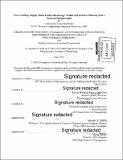| dc.contributor.advisor | Daniel Whitney and Donald Rosenfield. | en_US |
| dc.contributor.author | Kafka, Concepcion Alexandra | en_US |
| dc.contributor.other | Leaders for Global Operations Program. | en_US |
| dc.date.accessioned | 2015-09-29T18:57:55Z | |
| dc.date.available | 2015-09-29T18:57:55Z | |
| dc.date.copyright | 2015 | en_US |
| dc.date.issued | 2015 | en_US |
| dc.identifier.uri | http://hdl.handle.net/1721.1/99006 | |
| dc.description | Thesis: M.B.A., Massachusetts Institute of Technology, Sloan School of Management, 2015. In conjunction with the Leaders for Global Operations Program at MIT. | en_US |
| dc.description | Thesis: S.M., Massachusetts Institute of Technology, Engineering Systems Division, 2015. In conjunction with the Leaders for Global Operations Program at MIT. | en_US |
| dc.description | Cataloged from PDF version of thesis. | en_US |
| dc.description | Includes bibliographical references (pages 65-66). | en_US |
| dc.description.abstract | The two objectives of this project were to develop an understanding of the challenges and opportunities of the supply chain of a family of currently marketed products manufactured overseas and distributed/sold worldwide and to increase the agility of the supply chain while achieving a target service level of 99% and maintaining or decreasing costs. A model was created to explore the current supply chain as well as the idea of supply chain agility through the implementation of postponement as models can easily be used to understand the cause and effect relationships through the ability to analyze any number of possible outcomes in a time and cost effective manner. Monthly demand and forecast data was analyzed to determine if there were in biases in the forecasts and to understand the relation between demand and forecast error through the use of a power law model. The forecast and demand data demonstrated a strong log-log relationship between RMSE and demand implying that there are economies of scale when demand is aggregated. The model shows that the implementation of postponement can reduce overall inventory levels, leading to decreased supply chain costs (if the cost of implementing postponement is less than the savings achieved through the inventory decrease). In looking at air versus ocean transport, the savings coming from inventory reduction due to decreasing lead times outweighed the increase in costs for both supply chain designs. As expected, increasing forecast accuracy leads to a decrease in safety stocks while decreasing forecast accuracy leads to an increase. Finally, increasing demand lead to increasing safety stocks and costs while decreasing demand had the opposite effect. For the forecast accuracy and changing demand scenarios there is a larger magnitude of savings for the current design of the supply chain than for one with postponement. | en_US |
| dc.description.statementofresponsibility | by Concepcion Alexandra Kafka. | en_US |
| dc.format.extent | 66 pages | en_US |
| dc.language.iso | eng | en_US |
| dc.publisher | Massachusetts Institute of Technology | en_US |
| dc.rights | M.I.T. theses are protected by copyright. They may be viewed from this source for any purpose, but reproduction or distribution in any format is prohibited without written permission. See provided URL for inquiries about permission. | en_US |
| dc.rights.uri | http://dspace.mit.edu/handle/1721.1/7582 | en_US |
| dc.subject | Sloan School of Management. | en_US |
| dc.subject | Engineering Systems Division. | en_US |
| dc.subject | Leaders for Global Operations Program. | en_US |
| dc.title | Understanding supply chain trade-offs through models and scenario planning with a focus on postponement | en_US |
| dc.type | Thesis | en_US |
| dc.description.degree | M.B.A. | en_US |
| dc.description.degree | S.M. | en_US |
| dc.contributor.department | Leaders for Global Operations Program at MIT | en_US |
| dc.contributor.department | Massachusetts Institute of Technology. Engineering Systems Division | |
| dc.contributor.department | Sloan School of Management | |
| dc.identifier.oclc | 921184281 | en_US |
